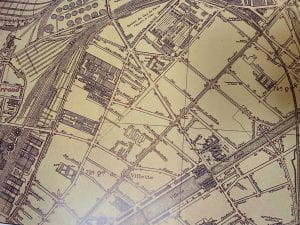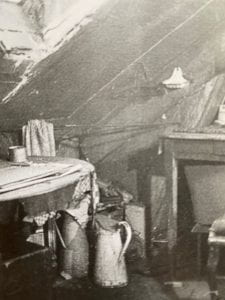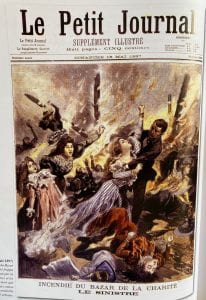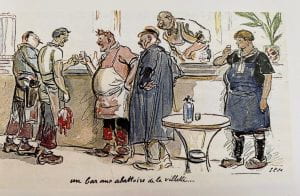LES POMPES FUNÈBRES
- Municipal service, “l’usine à deuil” = “The mourning factory”, that organized the passage from life to death in Paris from 1874 to 1998.
- Death culture and its representation and rituals are vital in each societies
Chapter 1: “Mourir à Paris”
- The daily deaths determined the evolution of the establishment.
- 1st January 1860: annexation of 11 communes including the Villette commune which houses the 104. It is a time of industrialization.
- Factories and workshops are moving away from the city, especially in the East, in communes like : La Chapelle, La Villette, Ménilmontant, Belleville etc. In the 1950s it will move even farther into the suburbs.
- Mortality rate in France goes from 21,4 % in 1874 to 9.1% in 1999, which decreases the Pompes funèbre’s activity.
- 1870-1871 were times of war, famine and epidemics (typhus and smallpox).
- Until the second half of the 20th century, Tuberculosis was the most notable disease. Soldiers and prostitutes were hardly hit by Syphilis.
- The Morve was a disease spread by horses and the workers of the 104 weren’t spared as they housed many, and were right next to the Villette slaughterhouse who killed thousands of horses annually.
- As child deaths went down with the years, it didn’t stop heat waves and harsh winters from claiming its victims, especially children. 1911 was the most murderous in that context in Paris.
- There were also industrial accidents, like the 1938 explosion of Villejuif, the fire of 1897 in Bazar de La Charité (177 deaths) or the metropolitan accident of the Couronne station in 1903 (77 travelers dead).
- The World Wars had there highest death numbers, with bodies coming in decapitated from bombings and artillery. January 1941 was the 104’s highest activity with 5429 funeral convoys; causes of death ranged from Nazi executions to famine in the poorest populations. 19th of August 1944 was named the “Semaine Sanglante” during the Liberation as the city turned into a battlefield. The Pompes Funèbre’s work was enormous as they had to clear out the bodies as soon as possible to avoid diseases.
Chapter 2: “Vivre à la Villette”
- In 1860, the Villette neighborhood already had 30 000 habitants and was an industrial area with a lot of workers. The bassin de La Villette, with the Canal de L’Ourcq and Canal St-Martin became a true port in 1813. In 1849, the inauguration of railway tracks and Gare de l’Est separated the neighborhood from the rest of Paris. It is at that time that they decide to build the establishment of the Pompes Funèbres.
- Through the Canals was brought the wood needed for the coffins, and the railways housed the funeral trains.
- They said that each Paris neighborhood had their smell, and this neighborhood reeked of death, from the Pompes Funèbres to the slaughterhouses. Even a few years before the 104’s construction, as most popular areas of Paris which housed lower class citizens, death was omnipresent. Even the canals surrounding it were full of suicidal bodies. In the years following WWI, many traumatized soldiers who mostly lived in this area shot themselves in the head often.
104 history: chapt 1&2. (PDF for better image quality)




